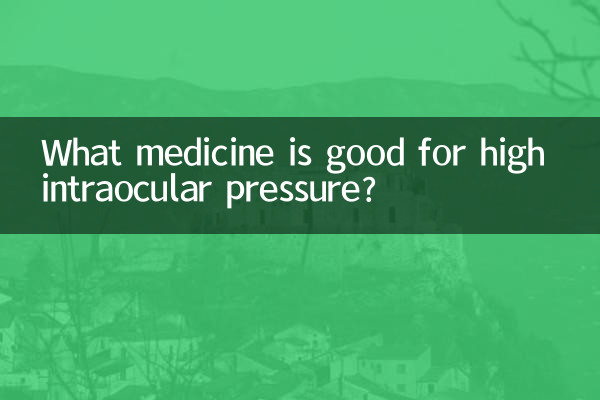What medicine is good for high intraocular pressure?
High intraocular pressure is one of the main symptoms of glaucoma. Long-term high intraocular pressure may lead to optic nerve damage and even blindness. For the treatment of high intraocular pressure, medication is one of the common options. This article will combine the hot topics and hot content on the Internet in the past 10 days to give you a detailed introduction to medication selection and precautions for high intraocular pressure.
1. What is high intraocular pressure?

Intraocular pressure refers to the pressure inside the eyeball, and the normal range is 10-21 mmHg. When the intraocular pressure exceeds 21 mmHg, it is called intraocular hypertension. Common causes of high intraocular pressure include aqueous humor circulation disorder, glaucoma, eye inflammation, etc.
2. The dangers of high intraocular pressure
Long-term high intraocular pressure can lead to optic nerve atrophy, which can lead to visual field loss or even blindness. Therefore, timely control of intraocular pressure is crucial.
3. Commonly used drugs for high intraocular pressure
The following are commonly used clinically used intraocular pressure-lowering drugs and their mechanisms of action:
| drug class | Representative medicine | Mechanism of action | Common side effects |
|---|---|---|---|
| prostaglandin analogs | Latanoprost, travoprost | Increased aqueous humor outflow | Conjunctival congestion and eyelash growth |
| beta blockers | timolol, betaxolol | Reduce aqueous humor production | Slowing heart rate, worsening asthma |
| carbonic anhydrase inhibitor | Dorzolamide, Brinzolamide | Inhibit aqueous humor production | Bitter mouth, electrolyte imbalance |
| α2 receptor agonist | Brimonidine | Reduce aqueous humor production and increase outflow | Dry mouth, drowsiness |
| hypertonic agent | Mannitol, glycerin | Quickly lower intraocular pressure (for emergency use) | Headache, electrolyte imbalance |
4. How to choose the appropriate drug?
1.prostaglandin analogs: A first-line drug suitable for long-term use, with significant intraocular pressure lowering effect and fewer side effects. 2.beta blockers: Suitable for patients without cardiovascular or respiratory diseases. 3.carbonic anhydrase inhibitor: Often used for auxiliary treatment, oral preparations have greater side effects, and eye drops are safer. 4.α2 receptor agonist: Suitable for patients who cannot tolerate other drugs. 5.hypertonic agent: Only used for emergency blood pressure reduction when acute intraocular pressure rises.
5. Medication precautions
1. Strictly follow the doctor's instructions when taking medication, and do not adjust the dosage or stop medication on your own. 2. If serious side effects occur (such as difficulty breathing, abnormal heart rate), seek medical attention immediately. 3. Some drugs need to be used for a long time, and intraocular pressure and optic nerve function should be reviewed regularly. 4. Clean your hands before using eye drops and avoid contact of the bottle mouth with your eyes.
6. Other auxiliary treatment methods
1.lifestyle adjustments: Avoid bowing your head for a long time, staying up late, and reduce caffeine intake. 2.laser treatment: Suitable for patients with poor medical control, such as laser trabeculoplasty. 3.surgical treatment: Trabeculectomy may be considered for severely ill patients who fail to respond to drug and laser treatments.
7. The correlation between hot topics in the past 10 days and high intraocular pressure
Recently, there has been a heated discussion about whether long-term use of electronic devices will lead to increased intraocular pressure. Studies have shown that staring at a screen for a long time may reduce blinking, affect aqueous humor circulation, and indirectly increase the risk of intraocular pressure. Therefore, it is recommended to take a break every 20 minutes and relax your eyes while looking far away.
8. Summary
The treatment of high intraocular pressure requires individualized drug selection. Prostaglandin analogs and beta-blockers are commonly used first-line drugs. Patients should strictly follow medical advice, conduct regular reviews, and make lifestyle adjustments to protect visual function. If you feel unwell, seek medical advice promptly.
The above content is for reference only. Please consult a professional ophthalmologist for specific medication.

check the details

check the details